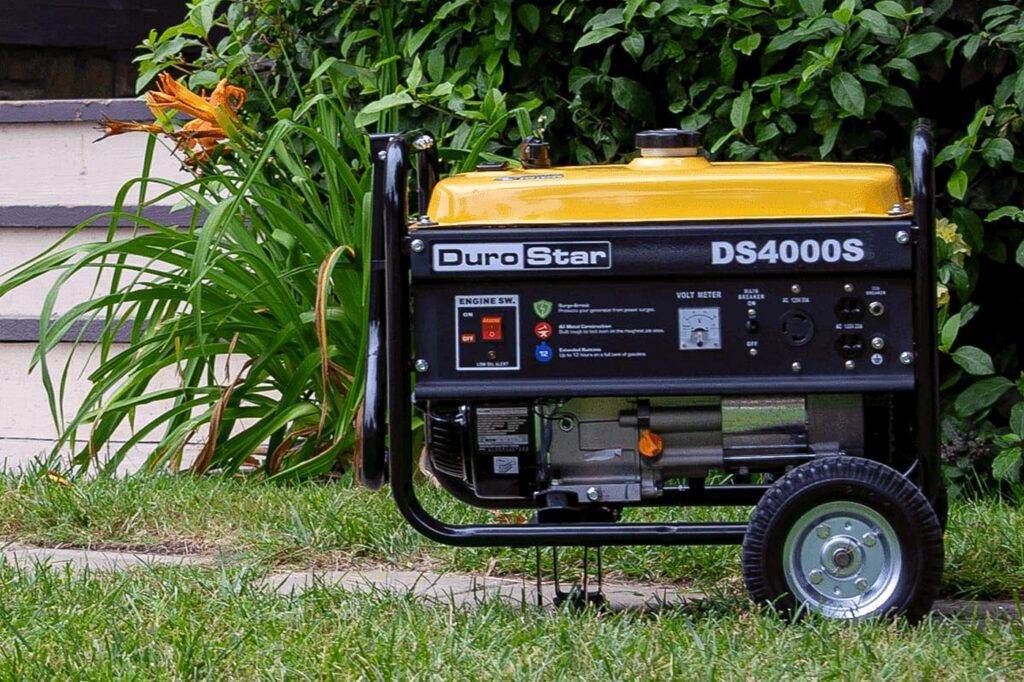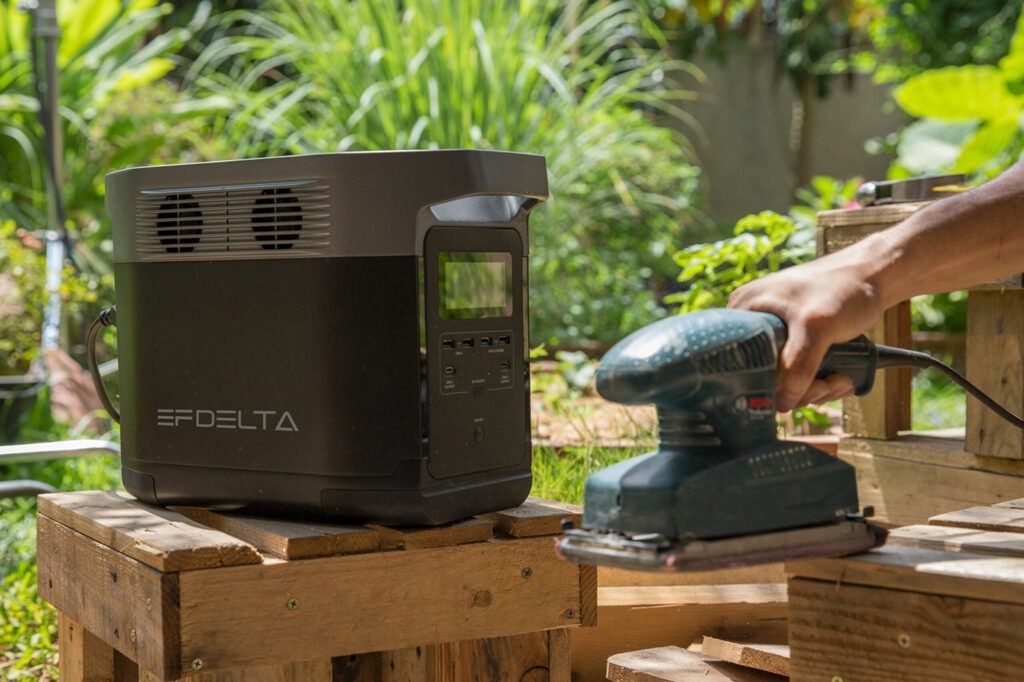Whether you’re preparing for potential power outages at home, or need to power your devices while camping, RVing, or tailgating, having a generator on hand is essential. Generators provide power to your most critical devices when the grid is down and can even power your entire home in some cases.
This guide will cover what devices you can power with a generator, the different fuel sources available, the difference between whole-house and portable generators, and more. Here are the most important things to keep in mind when shopping for a generator.
Types of Generators
There are four main types of generators, each with its own advantages and disadvantages:
Home Standby Generators
A standby home generator is a heavy-duty device that provides backup power to your home during an electrical outage. These whole-house generators are permanently installed and hardwired into your home’s electrical system. Professional installation is recommended to ensure proper setup, adherence to local ordinances, and noise restrictions. Connected via a transfer switch, a standby generator automatically kicks on when it detects a power outage and shuts off when power is restored.
Portable Generators
Portable generators are versatile and can be used in any open space. They are ideal for camping, hiking, or RV trips when you only need to power a few devices. Portable generators come in various sizes, with larger models offering more power than smaller ones.
Typically running on gasoline, portable generators are less expensive than standby generators but can power fewer items. These generators usually require extension cords unless you purchase a manual transfer switch.
Inverter Generators
An inverter generator is a type of portable generator that adapts to the power demand by throttling up and down its engine speed. This technology results in lower noise levels and improved fuel efficiency.
Solar Generators
A solar generator, also known as a portable power station, functions like a large battery that is charged by plugging into an outlet or using solar panels. These generators do not use propane or gasoline and are typically lightweight and portable. Solar generators are ideal for short-term use and powering a small number of devices, as they may have limited runtimes. The absence of an engine makes solar generators quiet, which is a significant benefit for noise-sensitive environments.
How Much Power Do You Need?
One of the most important factors when buying a generator is determining your power needs.
Standby generators are designed to meet the power demands of most, if not all, of your home appliances. In most cases, a 20kW generator should be sufficient to power the majority of your household devices.
If you’re using a portable generator, you’ll need to consider the power requirements of each device you plan to use. Larger portable generators can power more devices but are harder to move and maintain.
“The larger the generator, the more it weighs, the bigger it is, and the more fuel it takes,” says Melanie Tydrich, a generator expert from Kohler. “Some people are going to say, well, I’m just going to get the biggest generator I possibly can, and then I don’t have to worry about it. But realize, if you do that, you’re going to be burning a lot more fuel, and it’s going to take up a lot more space.”
To determine what size generator you need, you can calculate your power requirements using a chart like the one below, which provides a general estimate of the wattage used by common household items.
Common Household Items
| Item | Power |
|---|---|
| Aquarium | 50-1,200 watts |
| Ceiling fan | 65-175 watts |
| Coffee maker | 600-1,200 watts |
| Desktop computer | 125-200 watts |
| Dryer | 2,000-6,000 watts |
| Laptop | 20-75 watts |
| Microwave | 700-1,500 watts |
| Portable heater | 750-1,500 watts |
| Refrigerator | 500-1,000 watts |
| Sump pump | 800-1,000 watts |
| Tablet | 10-20 watts |
| Television (42-inch) | 200-300 watts |
| Toaster oven | 1,000-1,200 watts |
| Vacuum cleaner | 300-1,500 watts |
| Washing machine | 500-1,200 watts |
| Water heater | 4,000-5,000 watts |
| Well pump | 750-1,000 watts |
| Window air conditioner | 400-1,200 watts |


How to Operate a Generator Safely
While generators are useful, they can be dangerous if proper safety precautions aren’t taken. Here are some safety tips to keep in mind:
- Carefully read the owner’s manual before operating a portable generator to familiarize yourself with its operation.
- Use a fuel stabilizer when storing gasoline for extended periods. Unstabilized gas can become a fire hazard.
- Avoid refilling your generator when it’s hot or near warm objects to ensure safe operation.
- Connect your generator to a transfer switch to minimize the risk of electrocution or damage to your appliances. When in doubt, consult a qualified electrician to install the transfer switch.
- Position your generator at least five feet away from any surrounding surfaces to prevent overheating and potential fire hazards.
- Never operate a gas generator in an enclosed space. This can lead to a buildup of carbon monoxide, which could be lethal. Always operate your generator at least 20 feet away from your home.
“If you’re running a portable generator, you’re going to have to take it out of storage, put it in place somewhere safe outside, away from intake vents and not on a screened-in porch,” says Tydrich. “Take that carbon monoxide seriously. […]Have a carbon monoxide detector in the home so if all else fails, at least you’ve got another backup. People don’t realize that it’s an undetectable gas until it’s too late.”
What is a Transfer Switch?
Transfer switches provide a safe way to connect your generator to your home’s electrical panel via a cable. They allow you to switch between grid power and generator power.
Automatic transfer switches are integrated into standby generators and automatically switch between the power grid and generator power when they detect a blackout. Manual switches require you to manually switch over the power at the electrical panel.
Without a transfer switch, portable generators rely on extension cords, which can be hazardous and limit the devices you can power. If you use extension cords, ensure they are properly rated for the current they will be carrying.
Types of Fuel Used in Generators
Generators can run on gasoline, propane, natural gas, diesel, or solar energy.
Gasoline
Gasoline-fueled generators are the most common type of portable generator. When using a gas generator, it’s crucial to have an adequate supply of gasoline on hand and be aware of its limited shelf life.
“During an outage, a lot of gas stations either don’t have gasoline, or they have really long lines,” cautions Tydrich. “If you’re going to store gasoline, you need to realize it has a shelf life. You need it to be fresh gasoline, and you’re going to need to go out and refuel it periodically.”
Propane
Propane is a clean-burning fuel source often used in standby generators. Some portable generators also use propane as a backup fuel source or connect to a propane tank. Propane is an affordable fuel option but is less efficient and powerful than other fuel sources.
Diesel
Diesel is another popular fuel choice for portable generators. It can be stored for longer periods than gasoline and presents a lower fire risk. However, diesel is more commonly used in industrial-style generators.
Natural Gas
Natural gas is exclusively used in standby generators and is supplied through a home’s natural gas line. The main advantage of natural gas is its nearly limitless fuel supply, eliminating concerns about running out of gas, diesel, or propane. However, it is less energy-efficient than other fuel types.
Solar
Solar generators utilize energy from the sun to provide backup power via solar panels during power outages. Solar energy is free, clean, and energy-efficient, but it’s recommended to have a backup generator in place when using a solar generator. A battery backup, like a power reserve, can store energy and supply power when solar energy cannot be generated. You can also switch between solar power and other power sources to conserve energy and lower energy costs.
How Much Should You Spend on a Generator?
The cost of a generator varies depending on the type. Start by determining your power needs and whether you’ll invest in a standby generator or purchase a portable, inverter, or solar generator.
For standby generators, factor in installation costs in addition to the product cost, unless you have extensive DIY experience. The price can vary significantly depending on your property. New construction with an ideal generator location may cost around $3,000. However, complications can increase the cost considerably.
Tydrich explained factors that can increase installation costs: “If you’re in a situation where there’s nowhere safe to place the generator near the home because you either have windows that people open, air intakes, or other kinds of complications,” said Tydrich, “you may be running pipe and conduit to the other side of the property; there may be electrical system updates that need to take place, or you may not have natural gas or propane. The cost can really vary by thousands of dollars.”
Portable generators have a fixed price based on their power output and fuel source. Portable generators can range from a few hundred dollars to over $2,500 for higher-end models.
Differences Between AC and DC Generators
When shopping for generators, you might notice some are AC powered and others are DC powered. AC stands for “alternating current,” and AC units are the most common for household appliances. DC, or “direct current,” is more often used in battery banks and backup units. If using a DC generator, you’ll need to convert it to AC to have usable power.
Other Key Features to Look for in a Generator
Performance, type, fuel source, and safety features are crucial when buying a generator, but many models offer additional features.
Automatic CO Shutoff
Some generators have an automatic carbon monoxide shutoff that activates when dangerous gas levels are detected. This feature is common in newer portable generator models, providing added safety.
Electric Start
Many portable generators offer an electric start feature, allowing you to start the generator with a switch, remote, or push-button instead of a pull cord.
Low-Oil Shutoff
Some generators include a low-oil shutoff feature, which automatically shuts off the generator when the oil level drops below a certain point. Regularly monitor your generator’s oil and filter and change them when needed. If you’re not comfortable doing it yourself, consult a professional.
Fuel Gauge
A fuel gauge allows you to easily monitor the fuel level and know when to refuel a gas- or diesel-powered generator.
Noise Level
The noise level of a generator can be a factor, especially if you’re running it near your home or campsite. Quieter generators operate around 50-60 decibels, while louder generators can reach 90-100 decibels.
Choosing the right generator depends on your individual needs and circumstances. By considering the factors discussed in this guide, you can make an informed decision and ensure you have the power you need when you need it most.
